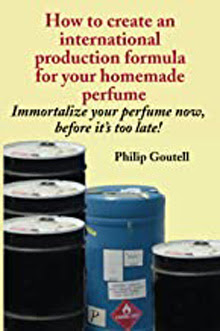To create a great perfume you need a great formula. To create an average perfume you need a ... formula. To create even a stinky perfume you need a ... formula. Excluding packaging, the formula is the heart of your perfume. Where will you get it?
We usually think of perfume as something someone has created. Every major launch by every major fragrance marketer involves an original perfume formula that has been created by a major fragrance (F&F) house.
If you get together with a group of investors to market your own perfume, you will almost certainly employ the talents of a professional perfumer, introduced to you by a smaller, less well known fragrance house, who will create a formula for your perfume.
Whether a perfume formula is created by a major or a minor fragrance house, the formula itself will remain with the creator, not you. While you will pay to have the work done, you will never see the formula that was created on your dime. Formulas are trade secrets, carefully guarded by fragrance creators.
Now suppose you want to develop your own perfume but you are not flush with enough money to hire a professional perfumer. You want to produce your own perfume but you can't do it without a formula – or can you? A simple solution is to buy one of the many quite acceptable fragrance oils already on the market. They were made using formulas you will never see but, as you can get the oil ready made, you don't need to see the formula. For the non-creator this is the perfect solution.
Now suppose you want control over the formula. Suppose you want it in your hands so you can mix the recipe yourself to produce the oil and perhaps make a few adjustments as you go along. Here you have three possibilities. You can buy a formula from someone who is willing to sell one, perhaps a perfumer who has a formula he or she isn't intent on keeping as a trade secret Or you may get lucky and find a formula that has, for whatever reason, been posted somewhere on the internet Or you can create your own formula, if you have the skill.
Creating your own formula can be the most rewarding path but also the most challenging. You need skills: you need aroma materials to work with and, when you're finished, the fragrance you have created is not likely to be anywhere near as polished and professional as any fragrance available at the mall or in a drugstore.
This doesn't mean your fragrance can't be good. Following your own muse you may create something quite beautiful, quite compelling, and quite different than anything on the market. But it won't be quite as polished. A few rough edges will exist. Yet if people like it – a good possibility – the rough edges will be overlooked.
If creating your own perfume from scratch – from a formula you've written yourself – is your goal, an excellent starting point is the home study Perfumery Training Kit K26 from PerfumersWorld. The course includes both materials and equipment and is quite reasonably priced.
Finding a formula somewhere on the internet is another not impossible possibility. Books on perfumery with formulas exist. Written many years ago, the formulas are generic and old fashioned. Moreover, they require materials no longer obtainable due to various reasons. Formulas from this age of "all natural" perfumes can be found in Piesse. Bland by today's standards, they were drafted in an age that had not yet enjoyed the benefits of synthetic odorants.
On the other hand, if you find a modern formula such as Honey Lips Kiss Macaron Au Cassis, you will have difficulty obtaining the required odorants as some are "captives" whose distribution is tightly controlled by the patent holder – Givaudan in this case. Then, working from the idea of the formula, you are forced to find acceptable substitutes. In short, you will be required to reformulate the formula to get what you hoped for.
In my mind it all comes down to this: if you're an investor and want to market a perfume, go to a filling house or fragrance house that can hook you up with a qualified perfumer and then let that perfumer develop a perfume for you. If you don't have money but want your own perfume, work with a ready made, off the shelf fragrance and make it uniquely yours by naming it with a unique name that then becomes a trademark – your trademark – for your perfume.
If you want to produce a fragrance from a formula, doing all the mixing and weighing yourself, you can do it... but be warned.

